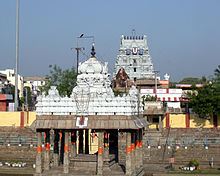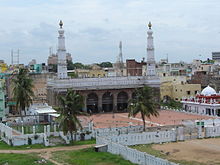Triplicans
Triplicane or Tiruvallikeni ( Tamil : திருவல்லிக்கேணி Tiruvallikkēṇi [ ˈt̪iɾɯʋalːikːeːɳi ]; also Thiruvallikeni ) is a district of Chennai (Madras), the capital of the Indian state of Tamil Nadu . Triplicane is home to the largest Muslim quarter in Chennai and the Vishnuitic Parthasarathy Temple .
Position and extent
Triplicane is located in the center of Chennai near the coast of the Bay of Bengal . The boundaries of the district are not precisely defined, but Triplicane can be demarcated from the districts of Mylapore in the south, Royapettah in the west and Chepauk in the north. In the east is the city beach Marina Beach .
Administratively, the Triplicane area belongs to the Teynampet zone . In the election for the Tamil Nadu Legislative Assembly (the parliament of the state), Triplicane has formed the constituency of Chepauk-Triplicane ( Chepauk-Triplicane constituency ) together with the neighboring districts of Chepauk and Chintadripet since 2011 . This includes the districts ( wards ) 62–63, 114–116 and 119–120. Previously, Triplicane had formed its own constituency.
history
The history of Triplicanes goes back much further than the Chennais, which was founded as a British colony in the 17th century. The Parthasarathy Temple of Triplicane dates back to the time of the Pallava rulers, who ruled from Kanchipuram over the northern part of what is now Tamil Nadu from the 6th to 9th centuries . In the 7th / 8th In the 19th century, three of the Alvars (Vishnuit poet saints) sing about the temple of Triplicane in their devotional hymns. The name Triplicane is an Anglicized form of Tiruvallikeni , which means something like "sacred ( tiru ) water lily pond ( alli-keni )" in Tamil .
After the British East India Company founded Fort St. George in 1639 , they also acquired the nearby village of Triplicane in 1659. The first Muslims had already settled in Triplicane in the 17th century during the occupation by the Golkonda sultanate . A larger Muslim community emerged in Triplicane after the Muslim dynasty of the Nawabs of Arcot moved their residence to nearby Chepauk in 1768. The Nawabs, who had controlled a large part of northern Tamil Nadu in the 18th century, gradually became dependent on the British East India Company. In 1801 they had to cede their territory to the British and were reduced to the status of pure titular rulers without political power. When the last nawab of Arcot died in 1855 without a male heir, their possessions fell to the British under the Doctrine of Lapse . But a relative of the Nawabs received in 1867 by the British the title "Prince of Arcot" ( Prince of Arcot ) and a number of privileges granted. The family of the princes of Arcot still resides in Triplicane today.
Triplicane retained a village character for a long time. It was not until the 20th century that Chennai expanded into a densely populated district.
Attractions
In the south of Triplicanes is the most important Vishnuit sanctuary of Chennai, the Parthasarathy Temple . He is consecrated to the god Krishna as Parthasarathy ("charioteer Parthas", i.e. Arjunas ). In this form Krishna, an avatar of the god Vishnu , appears in the Mahabharata epic. In addition to the main shrine dedicated to Krishna, the temple houses secondary shrines for Krishna's consort Rukmini and other avatars of Vishnu, namely Rama and Narasimha . The Parthasarathy Temple, built in the South Indian Dravida style , dates back to the time of the Pallava in the 8th century and was rebuilt and expanded several times in the later centuries. In its present form, the temple has a rectangular floor plan of around 120 × 42 meters. In the west and east there is a gopuram (gate tower), in front of the main entrance in the east there is also a pillared hall ( mandapa ). To the east of the temple is a large temple pond. The district surrounding the Parthasarathy Temple is traditionally inhabited by Vishnuit Brahmins from the Iyengar caste to this day .
The northern part of Triplicanes, however, is strongly influenced by Muslims . Which is located on the road Quaide Milleth Salai (formerly Triplicane High Road) Wallajah Mosque or "Great Mosque" ( Big Mosque ), the main Sunni mosque Chennai. It was built in 1795 under the nawab of Arcot Muhammed Ali Khan Wallajah and is still maintained today by his descendants. The mosque, made of gray granite, has two minarets. It stands in the middle of a spacious open area that offers space for large religious and cultural gatherings. Next to the mosque are the graves of the Sufi saint Maulana Abdul Ali Bahrul Uloom and the nawabs of Arcot.
The Amir Mahal is located on the border between Triplicane and the neighboring district of Royapettah . The building, in the Indo-Saracen colonial style, was originally built as an administrative building by the British East India Company in 1798 . After the Nawabs of Arcot were deposed in 1855 and had to give up their previous palace in Chepauk, the British converted the Amir Mahal into a palace as compensation and left it to the ruling family as a new residence in 1876. To this day it is owned by the descendants of the Arcot Nawabs.
traffic
Triplicane is connected to other parts of Chennais by numerous city bus routes. The Thiruvallikeni station of the Mass Rapid Transit System (MRTS) elevated railway is also located in Triplicane .
literature
- S. Muthiah: Madras that is Chennai. Gateway to the South. Chennai: Ranpar Publishers, 2005. pp. 52-55.
Web links
Individual evidence
- ↑ List of neighborhoods on the Chennai (Tamil) city website. (PDF; 420 kB)
Coordinates: 13 ° 3 ' N , 80 ° 17' E




